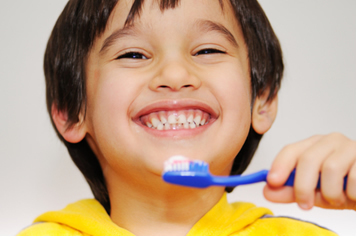From March 11th to 15th, 2013 the Annual School Health Mobilization Week. This mobilization will start important activities that must be applied throughout the year. This is the second edition of this project, and this time around 30,000 schools in 2300 municipalities will participate.
Approximately 14 million students from public elementary and high schools, as well as from day care centers and pre-schools, will pass for a screening during the week and the visit of health professionals will continue throughout the year to carry out a follow-up.
The central themes that will be covered are: childhood obesity and eye health. However, other aspects will be checked, one of which is the oral health assessment of students.
the prevention at this point it's important because contributes not only to improving learning, but also to the quality of life of children. After all, a student with a toothache cannot pay attention in class, that is, if he manages to go to school!
Our teeth are important in the process of chewing and eating food, as well as in the social aspect as well. There is embarrassment, relationship disorders and psychological disorders, as well as social isolation on the part of people who have infections, tooth decay and bad breath.

Caries is an infectious disease caused by poor oral hygiene, incorrect diet, salivary flow, microorganisms, among other aspects. Let's better understand how it develops:
- Teeth structure:
Teeth are mineralized structures that are implanted in the mandible and maxilla. The image below shows the three main parts of the anatomy of teeth: the crown, the neck and the root. It also shows the enamel, dentin, pulp and cementum that are found in the tooth structure:

There are nerve endings in dentin and pulp that, if affected by infectious processes, cause various types of pain. Dentin pain occurs when eating sweets or foods that are too cold and/or hot. The pulp pain is strong, much more intense than that of dentin, it is continuous, pulsating and spontaneous.
- Cavities formation process:
The main component of tooth enamel is the hydroxyapatite, a hard salt that is practically insoluble in water, having the following molecular formula: Here5OH(PO4)3(s).
Our mouth has a mild temperature, around 36ºC, it is permanently moist and has a flow of nutrients through our food. Thus, it becomes a favorable environment for the proliferation of microorganisms. Our saliva has proteins that form an invisible layer on our teeth, where bacteria accumulate. They feed on food sugars and proliferate, forming the so-called bacterial plaque orbiofilm.
Bacteria metabolize sugar and form acids such as lactic acid. Hydroxyapatite can be attacked by acids, so what we call demineralization, where the hydroxyapatite is dissolved, forming then cavities in the teeth and causing caries:

The consumption of acidic foods and beverages, such as soda, results in the presence of acids in our mouth, causing there to be H ions+ which will react with the hydroxyls (OH-), causing a shift in the equilibrium of the above reaction towards the direct reaction. the OH- are essential in the mineralization process and, being neutralized by H ions+, mineralization will be considerably reduced. This means that demineralization will be favored, hydroxyapatite will be more consumed and will weaken tooth enamel.
- Cleaning and sanitizing teeth (prevention of caries):
Brushing teeth with an alkaline paste, that is, one that has a pH greater than 7, causes this reaction to occur in the opposite direction, in the direction of mineralization.
Bacterial plaque builds up constantly, even on low-sugar diets; hence the importance of removing it with frequent brushing, especially when waking up, after meals and before bedtime, in addition to flossing.

If this is not done, mineral salts will be deposited on the teeth, causing the Tartarus. Tartar is more serious as this rigid structure can only be removed by the dentist.
The main constituents of toothpastes are substances that perform the functions of abrasive or polishing agent (A toothpaste can contain one or more types of abrasives). These compounds are insoluble in water and the most used are: calcium monohydrogen phosphate (CaHPO4), calcium carbonate (CaCO3), calcium pyrophosphate (Ca2P2O7), silicon dioxide (SiO2), magnesium oxide (MgO), sodium metaphosphate (NaPO3) and aluminum oxide (Al2O3).
These abrasives are basic, reducing the acidity of the mouth, because, as already mentioned, the acidic environment favors the formation of cavities.
Toothpastes also contain dye, foam, humectant, binder, sweetener, solvent and therapeutic agent. Flavorings, thickeners, preservatives and flavorings can also be added.
An important component of toothpastes are the fluorine salts (such as sodium monofluor phosphate (Na4(DUST4)F) and sodium fluoride (NaF)), as they help fight hydroxyapatite demineralization and keep teeth stronger. Note that these are "fluorine salts", so the ion that acts is fluoride (F-), and not just fluoride (F), as the toothpaste packaging says.
Notice how the fluoride ion (F-) Act:

Fluoride ions (F-) replace the OH ions- in hydroxyapatite, forming the fluorapatite (Here5F(PO4)3), which is even less soluble in water and makes tooth enamel more resistant to acid attack, since, as shown in the above balance, hydroxyl is not formed in its dissociation.
Thus, toothpastes have important functions, such as removing bacterial plaque, cleaning, polishing, whitening teeth, preventing and fighting caries and tartar.
By Jennifer Fogaça
Graduated in Chemistry
Source: Brazil School - https://brasilescola.uol.com.br/saude-na-escola/higiene-bucal-quimica-creme-dental.htm
